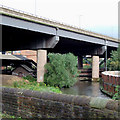
Mooring here is impossible (it may be physically impossible, forbidden, or allowed only for specific short-term purposes).
You can wind here.
| Birmingham Canal Navigations (Birmingham and Fazeley Canal - Main Line) | ||
|---|---|---|
| Factory over Canal (western end) | 4¼ furlongs | |
| Troutpool Bridge | 4¼ furlongs | |
| New Troutpool Bridge | 2¾ furlongs | |
| Site of Troutpool Basin | 2¾ furlongs | |
| Troutpool Pipe Bridge | 1¾ furlongs | |
| Salford Junction (south) | ||
| Salford Bridge Wharf | a few yards | |
| Salford Junction (north) | ¼ furlongs | |
| Salford Turnover Bridge | ¼ furlongs | |
| Aston Motorway Bridge | ¼ furlongs | |
| River Tame Aqueduct (Salford) | ½ furlongs | |
| Grand Union Canal (Birmingham and Warwick Junction Canal) | ||
| Salford Junction (south) | ||
| Salford Junction Bridge No 110 | a few yards | |
| Salford Junction Aqueduct | ½ furlongs | |
| Salford Junction Pipe Bridge | ½ furlongs | |
| Site of Salford Bridge Lock No 64 | 1½ furlongs | |
| Three Pipe Bridges | 1¾ furlongs | |
- Birmingham Canal Walks — associated with Birmingham Canal Navigations
- Sixteen walks along the Birmingham Canal Navigations with a detailed description, history and photographs.
Mouseover for more information or show routes to facility
Nearest water point
In the direction of Fazeley Junction
In the direction of Bordesley Junction
In the direction of Farmers Bridge Junction
Nearest rubbish disposal
In the direction of Fazeley Junction
In the direction of Bordesley Junction
In the direction of Farmers Bridge Junction
Nearest chemical toilet disposal
In the direction of Fazeley Junction
In the direction of Bordesley Junction
In the direction of Farmers Bridge Junction
Nearest place to turn
In the direction of Fazeley Junction
In the direction of Bordesley Junction
In the direction of Farmers Bridge Junction
Nearest self-operated pump-out
In the direction of Bordesley Junction
In the direction of Farmers Bridge Junction
Nearest boatyard pump-out
In the direction of Fazeley Junction
In the direction of Bordesley Junction
In the direction of Farmers Bridge Junction
Wikipedia has a page about Salford Junction
Salford Junction (grid reference SP095901) is the canal junction of the Grand Union and Tame Valley Canals with the Birmingham and Fazeley Canal. It is in the north of the administrative city of Birmingham, England and historically marked a tripoint between two divisions of Aston to the south and Erdington to the north. It is directly east of most of the Gravelly Hill Interchange (Spaghetti Junction). With Aston and Bordesley Junctions it forms a circuit, at the heart of Birmingham's thirty-five miles of canals.
















![Salford Junction. Where the Birmingham & Fazeley canal meets the Birmingham & Warwick Junction canal [now part of the Grand Union] and slightly further on, the Tame Valley canal. All under the M6 viaduct at Spaghetti Junction [Gravelly Hill interchange]. The B & F towpath rises up over the GU. by Christine Johnstone – 09 May 2022](https://s2.geograph.org.uk/geophotos/07/21/41/7214134_469c3401_120x120.jpg)








![Salford Bridge Junction - before the M6. Salford Bridge Junction is the point at which the Grand Union Canal (originally the Birmingham & Warwick) here straight ahead, meets the Birmingham & Fazeley Canal (to the left) & the Tame Valley Canal (to the right). Both the latter canals being part of Birmingham Canal Navigations. Just beyond the towpath footbridge (bridge 110) can be seen the parapets of the aqueduct that carries the GUCC over the River Tame. The area now is completely dominated by the Gravelley Hill interchange ('Spaghetti Junction') of the M6. For an almost identical 2012 view to mine see: [[3134599]].I am standing on Salford Bridge Wharf which was the main depot of T S Element Ltd, noted canal carriers in the Birmingham & Black Country area. A couple of their narrow boats are prominent. These are day boats ('joey boats') with limited accommodation because of the short distance nature of the traffic they carried. At their peak at the end of WW2 their fleet comprised of nearly 200 boats. They survived as canal carriers into the 1970s with just 6 boats working on factory rubbish contracts. For details see: http://www.workingboats.com/Elements.htm by Martin Tester – June 1968](https://s0.geograph.org.uk/geophotos/06/77/92/6779208_2b5441a6_120x120.jpg)
















